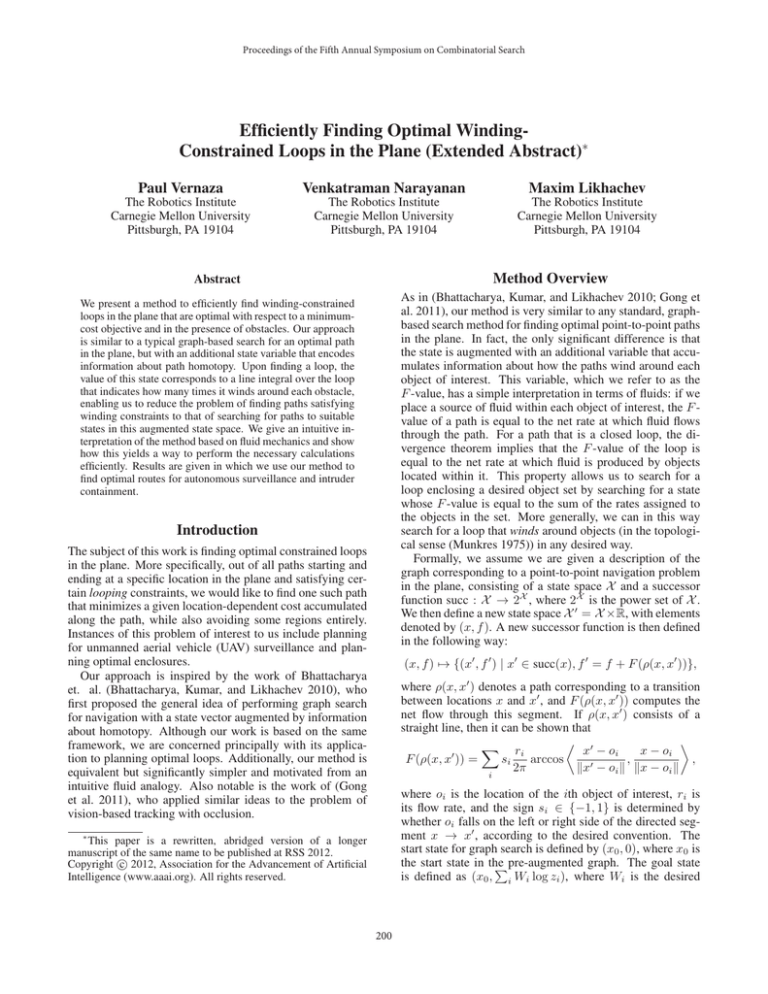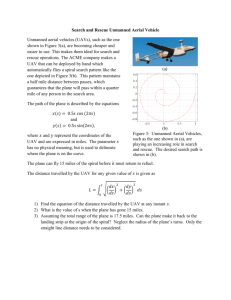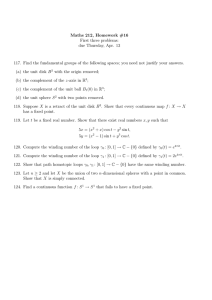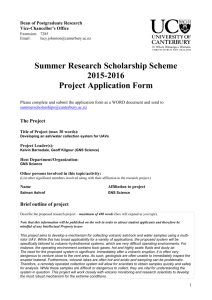
Proceedings of the Fifth Annual Symposium on Combinatorial Search
Efficiently Finding Optimal WindingConstrained Loops in the Plane (Extended Abstract)∗
Paul Vernaza
Venkatraman Narayanan
Maxim Likhachev
The Robotics Institute
Carnegie Mellon University
Pittsburgh, PA 19104
The Robotics Institute
Carnegie Mellon University
Pittsburgh, PA 19104
The Robotics Institute
Carnegie Mellon University
Pittsburgh, PA 19104
Method Overview
Abstract
As in (Bhattacharya, Kumar, and Likhachev 2010; Gong et
al. 2011), our method is very similar to any standard, graphbased search method for finding optimal point-to-point paths
in the plane. In fact, the only significant difference is that
the state is augmented with an additional variable that accumulates information about how the paths wind around each
object of interest. This variable, which we refer to as the
F -value, has a simple interpretation in terms of fluids: if we
place a source of fluid within each object of interest, the F value of a path is equal to the net rate at which fluid flows
through the path. For a path that is a closed loop, the divergence theorem implies that the F -value of the loop is
equal to the net rate at which fluid is produced by objects
located within it. This property allows us to search for a
loop enclosing a desired object set by searching for a state
whose F -value is equal to the sum of the rates assigned to
the objects in the set. More generally, we can in this way
search for a loop that winds around objects (in the topological sense (Munkres 1975)) in any desired way.
Formally, we assume we are given a description of the
graph corresponding to a point-to-point navigation problem
in the plane, consisting of a state space X and a successor
function succ : X → 2X , where 2X is the power set of X .
We then define a new state space X 0 = X ×R, with elements
denoted by (x, f ). A new successor function is then defined
in the following way:
We present a method to efficiently find winding-constrained
loops in the plane that are optimal with respect to a minimumcost objective and in the presence of obstacles. Our approach
is similar to a typical graph-based search for an optimal path
in the plane, but with an additional state variable that encodes
information about path homotopy. Upon finding a loop, the
value of this state corresponds to a line integral over the loop
that indicates how many times it winds around each obstacle,
enabling us to reduce the problem of finding paths satisfying
winding constraints to that of searching for paths to suitable
states in this augmented state space. We give an intuitive interpretation of the method based on fluid mechanics and show
how this yields a way to perform the necessary calculations
efficiently. Results are given in which we use our method to
find optimal routes for autonomous surveillance and intruder
containment.
Introduction
The subject of this work is finding optimal constrained loops
in the plane. More specifically, out of all paths starting and
ending at a specific location in the plane and satisfying certain looping constraints, we would like to find one such path
that minimizes a given location-dependent cost accumulated
along the path, while also avoiding some regions entirely.
Instances of this problem of interest to us include planning
for unmanned aerial vehicle (UAV) surveillance and planning optimal enclosures.
Our approach is inspired by the work of Bhattacharya
et. al. (Bhattacharya, Kumar, and Likhachev 2010), who
first proposed the general idea of performing graph search
for navigation with a state vector augmented by information
about homotopy. Although our work is based on the same
framework, we are concerned principally with its application to planning optimal loops. Additionally, our method is
equivalent but significantly simpler and motivated from an
intuitive fluid analogy. Also notable is the work of (Gong
et al. 2011), who applied similar ideas to the problem of
vision-based tracking with occlusion.
(x, f ) 7→ {(x0 , f 0 ) | x0 ∈ succ(x), f 0 = f + F (ρ(x, x0 ))},
where ρ(x, x0 ) denotes a path corresponding to a transition
between locations x and x0 , and F (ρ(x, x0 )) computes the
net flow through this segment. If ρ(x, x0 ) consists of a
straight line, then it can be shown that
0
X ri
x − oi
x − oi
0
F (ρ(x, x )) =
si
arccos
,
,
2π
kx0 − oi k kx − oi k
i
where oi is the location of the ith object of interest, ri is
its flow rate, and the sign si ∈ {−1, 1} is determined by
whether oi falls on the left or right side of the directed segment x → x0 , according to the desired convention. The
start state for graph search is defined by (x0 , 0), where x0 is
the start state in the
Ppre-augmented graph. The goal state
is defined as (x0 , i Wi log zi ), where Wi is the desired
∗
This paper is a rewritten, abridged version of a longer
manuscript of the same name to be published at RSS 2012.
c 2012, Association for the Advancement of Artificial
Copyright Intelligence (www.aaai.org). All rights reserved.
200
(a)
Figure 2: Results of intruder confinement experiments. Locations of intruders are marked by circles beside exclamation symbols. Locations of bystanders are marked by circles
beside question marks. Paths generated by the method are
shown superimposed on floor plan of environment. Robot
deployments and sensing/communications ranges indicated
by dashed circles.
Intruder confinement
(b)
We also studied the application of our method to a problem we refer to as intruder confinement. This problem consists of finding an optimal way to confine several intruders
in a maze-like environment, subject to the constraint that innocent bystanders should not be confined. Confinement is
achieved by surrounding the intruders with a team of robots
that deploy from a central location. A feasible deployment
strategy consists of a loop that winds around each intruder
exactly once without winding around a bystander. Fig. 2
demonstrates that the method is able to find optimal enclosures in highly irregular, maze-like environments.
Figure 1: Optimal plans (solid lines) for hypothetical UAV
surveillance missions. The UAV is constrained to take off
and return to a particular location, winding around ROIs
in desired ways. ROIs are designated by polygonal dashed
lines. Red, striped polygons denote high-traffic regions that
the UAV must avoid. Circular dashed lines denote location
and ranges of radar installations, with radar power decreasing with distance to center.
winding number of the solution path around the ith object
of interest and zi is the ith prime number. This assumes
ri = log zi ; setting the flow rates in this way ensures that
the map from winding winding configurations to F -values
is invertible, which can be proved by the fundamental theorem of arithmetic.
Discussion
A particular challenge for the method as implemented up to
this point is the case where many winding constraints are
to be enforced, in which case the the method may systematically explore different combination of windings until it
reaches the goal state. In the near-term, we anticipate that
employing straightforward heuristics will greatly enhance
the ability of the method to solve problems of this type.
Experiments
UAV surveillance
Acknowledgments
In this set of experiments, we applied our method to the
problem of finding optimal looping routes for a UAV tasked
with obtaining 360-degree views of regions of interest
(ROIs). We simulated hypothetical UAV missions by annotating aerial imagery of military bases with ROIs, hypothetical radar installations, and regions of excessive risk
to be avoided entirely. Radar installations were modeled
as overlapping ellipses, each containing a cost attaining its
maximum value at the center of the ellipse and diminishing
gradually to zero at the boundary of the ellipse. Our objective was to find minimum-cost loops subject to winding
constraints and entirely avoiding regions of excessive risk.
Results are shown in Fig. 1.
This research was sponsored by the ONR DR-IRIS MURI
project grant N00014-09-1-1052.
References
Bhattacharya, S.; Kumar, V.; and Likhachev, M. 2010.
Search-based path planning with homotopy class constraints. In SOCS.
Gong, H.; Sim, J.; Likhachev, M.; and Shi, J. 2011. Multihypothesis motion planning for visual object tracking. In
ICCV.
Munkres, J. 1975. Topology: a first course.
201



